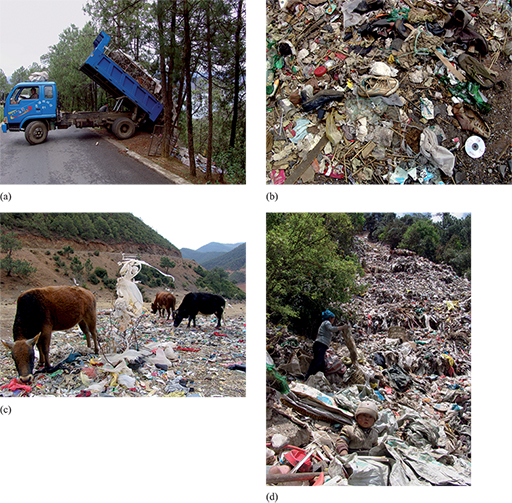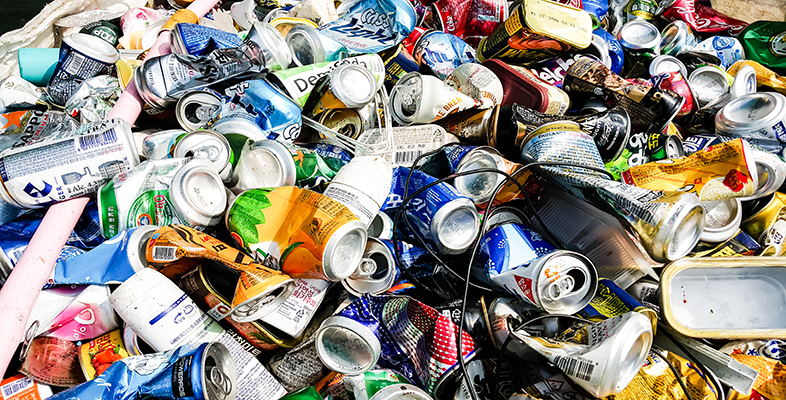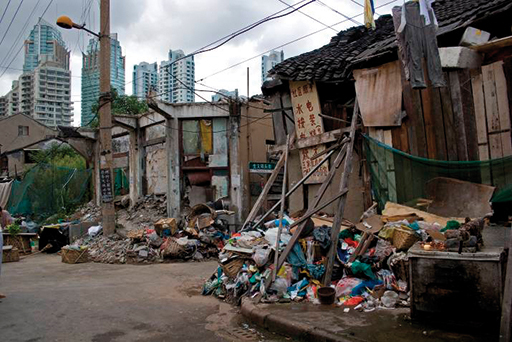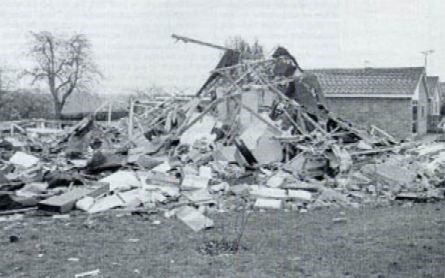1.1 Municipal solid waste in China
Solid waste produced by households is usually known as municipal solid waste (MSW). Definitions of what constitutes MSW vary but it usually compromises the waste from households together with some commercial wastes from shops and offices, street sweepings and some small businesses.
In cities such as Beijing, households can be diverse: from older, traditional ‘hutongs’ (a term which refers to an old alley or street normally lined with courtyard houses) to penthouse suites in modern high-rise, high-tech buildings. However, many hutongs are being cleared to make way for those higher-density modern high-rise buildings (Figure 3). As Chinese cities modernise and grow, the waste they produce increases and the composition changes, with more packaging, electronic waste and household appliances (Hoornweg et al., 2013).
At worst, high levels of waste can lead to ad hoc uncontrolled rubbish tips, which have no mechanisms for protecting the environment from the waste tipped into them. The liquids drained or ‘leached’ (the leachate) from rubbish sites can be very hazardous, and the methane gas generated from the decomposition of waste is both flammable and a greenhouse gas. If methane gas leaks out of rubbish dumps, there can be serious consequences. In 1986, a home in the UK was destroyed (Figure 4) by an explosion due to methane gas leaking from an old unregulated rubbish tip on adjacent land.
Apart from risks from leachate and methane emissions, the quantity of waste dumped can also be a problem. At the end of 2015, a huge amount of construction waste dumped on a hillside in the industrial area of Shenzhen, one of the wealthiest cities in China, caused a massive landslide that destroyed many buildings and killed 73 people (Mathews and Tan, 2016).
Elsewhere in China, the example of Luoshui village shows how uncontrolled rubbish tips develop. The village used to be a pristine example of a mountain village in the Yunnan province. It has been studied by a Chinese academic from Beijing Normal University, Professor Tian Song, and his story is outlined in Box 1.
Box 1 A case study: garbage of Lugu Lake, Yunnan province
Lugu Lake (泸沽湖) is a great and beautiful lake at the boundary of Yunnan and Sichuan Province, Southeast of China. More and more tourists have visited there since the 1980s.
In October 2000, I visited Lige (里格), a small village on the shore of Lugu Lake, Yongning County, Yunnan Province, which is the habitation of the famous Mosuo people (摩梭人), or Nari people (纳日人), a branch of the Naxi ethnic group (納西族). To my surprise, I found a garbage can in the center of the village. I lived in some small villages in north-eastern China during my childhood and I never saw such things in a traditional area. In my memory, everything in villages comes from dust, and goes back to dust. Residual food could become food for chicken and pigs; garbage from home cleaning was dumped to pig beds and would later be dug out as fertilizer. I was confused by the garbage can in the village. I predicted that there must be a garbage dump outside the village, not too far, not too close. But with only a few hours to stay there, I could not ask questions such as, where do you dump your garbage?
In September 2003, I met Zhao Hua (赵化), an anthropological photographer. […] One month later, Zhao Hua called me to say that she found, and was astonished by, the garbage dumps of Lige and especially Luoshui (Figure 5). For the latter, a hill several hundred meters long was covered by six years of garbage including plastic bottles, drinking packages, shoes, glass bottles and batteries. Nobody in the village visited there, nobody in the village knew how severe the garbage problem was. In my opinion, the garbage there had two origins: firstly that left by tourists; and secondly that produced by themselves after their living standard was raised.

When they made money they became richer and richer. They used more and more industrial products in their daily lives, such as washing powder, shampoo, plastic shoes, etc., which are signs of civilization, development, progress, and so on. As a consequence, more and more non-degradable garbage appeared. The villages are the bottom of the ‘downstream’ riverside; they can’t find their own location downstream for dumping their garbage, and can only dump their garbage in their own mountain. So, this case is a good illustration of my argument.
The pictures by Zhao Hua were seen by a China Central Television crew, and they asked me to help them produce a program. I hesitated at first and then agreed. Zhao Hua guided the production crew. I saw the program only when it was aired. They did not consider my explanation as given above, and still put it into a conventional pattern, that the garbage dumps were there because some officials were not dutiful. After the program was broadcast, the mayor of Lijiang government asked the county government to solve the problem. The garbage hill was closed for several days, and then, the garbage disappeared from the hill. Zhao Hua guessed that the garbage was burnt and then covered by earth. Later, interesting things happened. As for Luoshui, garbage was still produced every day, but officers dared not allow dumping in the original hill. They had to find a new place. At first, they wanted to dump the garbage in the mountain of another village, but the village refused to accept it. At last, they had to dig a place the size of a basketball court, on the land of the secretary of the village, as a temporary garbage dump. […] Since the Han dynasty, Nari people have lived around Lugu Lake. They drank lake water directly. But in 2000, I was told in Luoshui that the water close to shore was not drinkable, and people had to take a boat to the centre of the lake to draw drinkable water.


